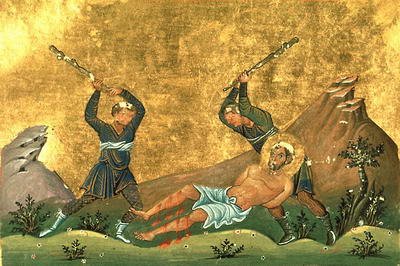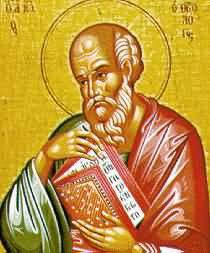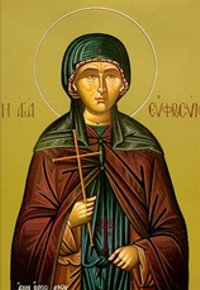|
|
The Holy Apostle Onesimus One of the Seventy, he was a slave of Philemon, a rich and distinguished citizen of Colossae in Phrygia. He offended his master in some way and fled to Rome, where he heard the Gospel from the Apostle Paul and was baptised. By this time, Paul had brought Philemon also to the true Faith, and he reconciled the two of them, Philemon and Onesimus, master and slave, writing a special epistle to Philemon - one of the most moving writings to be found in the New Testament: "I beseech thee for my son Onesimus, whom I have begotten in my bonds ... Perhaps he departed for a season, that thou shouldest receive him for ever, not now as a servant, but above a servant; a brother beloved." Deeply moved by this letter, Philemon received Onesimus as a brother indeed and gave him his freedom. Onesimus was later made bishop and received the see of Ephesus after the death of the Apostle Timothy. This is recorded in the epistles of Ignatius the God-Bearer. At the time of the persecution under Trajan, Onesimus, by then an old man, was arrested and taken to Rome. There he testified before the judge Tertylus, was imprisoned and finally slain. A wealthy woman took his body, placed it in a silver coffin and buried it, in the year 109. One of the Seventy, he was a slave of Philemon, a rich and distinguished citizen of Colossae in Phrygia. He offended his master in some way and fled to Rome, where he heard the Gospel from the Apostle Paul and was baptised. By this time, Paul had brought Philemon also to the true Faith, and he reconciled the two of them, Philemon and Onesimus, master and slave, writing a special epistle to Philemon - one of the most moving writings to be found in the New Testament: "I beseech thee for my son Onesimus, whom I have begotten in my bonds ... Perhaps he departed for a season, that thou shouldest receive him for ever, not now as a servant, but above a servant; a brother beloved." Deeply moved by this letter, Philemon received Onesimus as a brother indeed and gave him his freedom. Onesimus was later made bishop and received the see of Ephesus after the death of the Apostle Timothy. This is recorded in the epistles of Ignatius the God-Bearer. At the time of the persecution under Trajan, Onesimus, by then an old man, was arrested and taken to Rome. There he testified before the judge Tertylus, was imprisoned and finally slain. A wealthy woman took his body, placed it in a silver coffin and buried it, in the year 109.Our Holy Father Eusebius A Syrian hermit, he lived at first under the guidance of holy men, but later went into the solitude of the desert. He fed himself entirely on vegetable foods, never even tasting fruit, and spent all his time in prayer in the open air, enduring all weathers. He lived to the age of 95 and entered into rest in the Lord in 440. A Syrian hermit, he lived at first under the guidance of holy men, but later went into the solitude of the desert. He fed himself entirely on vegetable foods, never even tasting fruit, and spent all his time in prayer in the open air, enduring all weathers. He lived to the age of 95 and entered into rest in the Lord in 440.Martyr Major of Gaza (304)Martyr Major suffered for Christ in Gaza during the reign of Diocletian in 304
Venerable Paphnutius and his daughter St. Euphrosyne The Holy Martyr Paphnutius hailed from Egypt and struggled in the desert. During the persecution against Christians under Diocletian (284-305), the governor Hadrian commanded that St Paphnutius be brought to him. The ascetic, not waiting for those sent to bring him, appeared before the governor, confessed his faith in Christ, and was subjected to torture.
The soldiers involved in his torture, Dionysius and Callimachus, seeing how the power of God preserved the martyr, believed in Christ the Savior themselves, for which they were then beheaded. Cast into prison after the tortures, St Paphnutius converted forty prisoners to the Faith. They were all burned alive.
After a while St Paphnutius was set free, and a Christian named Nestorius gladly took him in. He and all his family, after spiritual guidance, became steadfast in the Faith, and ultimately endured martyrdom. The saint strengthened many other Christians to confess our Lord Jesus Christ, and they all died as martyrs. Some were cut with swords, others were burned. There were 546 men in all.
St Paphnutius himself was thrown by the torturers into a river with a stone about his neck, but he miraculously floated to shore with the stone. Finally, they sent the holy martyr to the emperor Diocletian himself, who commanded him to be crucified on a date tree.
St Paphnutius is also commemorated on September 25.
Saint Euphrosyne of Alexandria was born at the beginning of the fifth century in the city of Alexandria. She was the only child in her family of illustrious and rich parents. Since her mother died early, she was raised by her father, Paphnutius, a deeply believing and pious Christian. He frequented a monastery, the igumen of which was his spiritual guide.
When Euphrosyne turned eighteen, her father wanted her to marry. He went to the monastery to his spiritual guide to receive his blessing for the planned wedding of his daughter. The igumen conversed with the daughter and gave her his blessing, but St Euphrosyne yearned for the monastic life.
She secretly accepted tonsure from a wandering monk, left her father’s house and decided to enter a monastery in order to lead her life in solitude and prayer. She feared, however, that in a women’s monastery her father would find her. Calling herself the eunuch Smaragdos, she went to the very same men’s monastery which she had visited with her father since childhood.
The monks did not recognize Euphrosyne dressed in men’s garb, and so they accepted her into the monastery. Here in a solitary cell, St Euphrosyne spent 38 years in works, fasting and prayer, and attained a high level of spiritual accomplishment.
Her father grieved over the loss of his beloved daughter and more than once, on the advice of the igumen, he conversed with the monk Smaragdos, revealing his grief and receiving spiritual comfort. Before her death, the nun Euphrosyne revealed her secret to her grieving father and asked that no one but he should prepare her body for burial. Having buried his daughter, Paphnutius distributed all his wealth to both the poor and to the monastery, and then he accepted monasticism. For ten years right up to his own death, he labored in the cell of his daughter.
Saint Euphrosyne is also commemorated on September 25. The Holy Martyr Paphnutius hailed from Egypt and struggled in the desert. During the persecution against Christians under Diocletian (284-305), the governor Hadrian commanded that St Paphnutius be brought to him. The ascetic, not waiting for those sent to bring him, appeared before the governor, confessed his faith in Christ, and was subjected to torture.
The soldiers involved in his torture, Dionysius and Callimachus, seeing how the power of God preserved the martyr, believed in Christ the Savior themselves, for which they were then beheaded. Cast into prison after the tortures, St Paphnutius converted forty prisoners to the Faith. They were all burned alive.
After a while St Paphnutius was set free, and a Christian named Nestorius gladly took him in. He and all his family, after spiritual guidance, became steadfast in the Faith, and ultimately endured martyrdom. The saint strengthened many other Christians to confess our Lord Jesus Christ, and they all died as martyrs. Some were cut with swords, others were burned. There were 546 men in all.
St Paphnutius himself was thrown by the torturers into a river with a stone about his neck, but he miraculously floated to shore with the stone. Finally, they sent the holy martyr to the emperor Diocletian himself, who commanded him to be crucified on a date tree.
St Paphnutius is also commemorated on September 25.
Saint Euphrosyne of Alexandria was born at the beginning of the fifth century in the city of Alexandria. She was the only child in her family of illustrious and rich parents. Since her mother died early, she was raised by her father, Paphnutius, a deeply believing and pious Christian. He frequented a monastery, the igumen of which was his spiritual guide.
When Euphrosyne turned eighteen, her father wanted her to marry. He went to the monastery to his spiritual guide to receive his blessing for the planned wedding of his daughter. The igumen conversed with the daughter and gave her his blessing, but St Euphrosyne yearned for the monastic life.
She secretly accepted tonsure from a wandering monk, left her father’s house and decided to enter a monastery in order to lead her life in solitude and prayer. She feared, however, that in a women’s monastery her father would find her. Calling herself the eunuch Smaragdos, she went to the very same men’s monastery which she had visited with her father since childhood.
The monks did not recognize Euphrosyne dressed in men’s garb, and so they accepted her into the monastery. Here in a solitary cell, St Euphrosyne spent 38 years in works, fasting and prayer, and attained a high level of spiritual accomplishment.
Her father grieved over the loss of his beloved daughter and more than once, on the advice of the igumen, he conversed with the monk Smaragdos, revealing his grief and receiving spiritual comfort. Before her death, the nun Euphrosyne revealed her secret to her grieving father and asked that no one but he should prepare her body for burial. Having buried his daughter, Paphnutius distributed all his wealth to both the poor and to the monastery, and then he accepted monasticism. For ten years right up to his own death, he labored in the cell of his daughter.
Saint Euphrosyne is also commemorated on September 25. Synaxis of Saint John the Theologian at Diaconissa
|